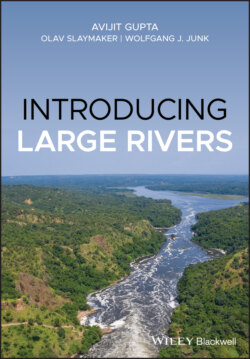Читать книгу Introducing Large Rivers - Avijit Gupta - Страница 14
2 Geological Framework of Large Rivers 2.1 Introduction
ОглавлениеA large river is a long river which drains an extensive basin, carries a big discharge, and usually, but not always, transports a huge quantity of sediment (Potter 1978). It possesses a suitable three-dimensional geological framework for achieving these characteristics. A linear depression in rock of considerable length commonly lies below the river. A sedimentary fill of varying depth rests on this depressed rock surface, and along with bedrock constitutes the material below the channel of the river. The fill has been deposited by the main river and its ancestors, and some of its sediment is contributed by tributary streams. On the surface, the long trunk river crosses a range of physical environments and changes form and behaviour several times. For example, the Irrawaddy, Narmada and Danube flow in and out of narrow rocky valleys and wide alluvial basins. The basin of a large river commonly is an accumulation of several sub-basins with different character, exhibiting a polyzonal form and behaviour. The end part of the main river needs to adjust to all such variations in the large basin, plus any change in sea level.
The geological framework of a large river is formed primarily by past large-scale tectonics. Its basin should also be big enough to collect sufficient precipitation to form and support a major river system. Conditions vary spatially within the basin of the large river, and different parts of the basin contribute water and sediment in varying fashion to the mainstream. The main river usually receives water from multiple parts of the basin, but almost all of its sediment is usually derived from higher tectonic parts of the catchment, an area of high relief and disintegrated rocks (Meade 2007; Milliman and Syvitski 1992). Usually, the sediment is derived from such areas by glaciation, slope failures, and eroding headstreams of the river.
In brief, the physical characteristics of a large river depend on its structural framework, its geological history, and its pattern of water and sediment supply. Such characteristics form and maintain the river and its basin. Their nature is modified over time following changes in tectonics and climate, and in current times also by anthropogenic alterations of the river and its basin.
